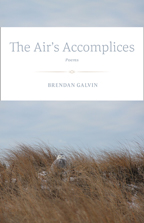 I’ve long been an avid admirer of Brendan Galvin’s poetry, and I won’t try to dodge the obvious: I wrote a jacket blurb for his new collection, The Air’s Accomplices. However, few potential readers beyond those who hold the book will see that recommendation, and I want to commend Galvin’s work to a potential audience that doesn’t have the volume in hand. The author is a contributing editor to this magazine, so I want to be transparent about personal and professional connections. But of course, Brendan became an advisor to Shenandoah because I trust his eye and ear and instincts, even that old-fashioned thing his spirit, as they are all manifest throughout his poems about what is born, begotten and dies. If questions of genre and appropriateness trouble anyone, perhaps it’s best to call this recommendation a brief “appreciation,” as well.
I’ve long been an avid admirer of Brendan Galvin’s poetry, and I won’t try to dodge the obvious: I wrote a jacket blurb for his new collection, The Air’s Accomplices. However, few potential readers beyond those who hold the book will see that recommendation, and I want to commend Galvin’s work to a potential audience that doesn’t have the volume in hand. The author is a contributing editor to this magazine, so I want to be transparent about personal and professional connections. But of course, Brendan became an advisor to Shenandoah because I trust his eye and ear and instincts, even that old-fashioned thing his spirit, as they are all manifest throughout his poems about what is born, begotten and dies. If questions of genre and appropriateness trouble anyone, perhaps it’s best to call this recommendation a brief “appreciation,” as well.
The natural world, the small town of his childhood, the historical cavalcade of the nineteenth century (and earlier) – you can find Galvin leaving his stamp on all these. His poems about Brendan the Navigator, explorers and scavengers, an Audubon-like naturalist and other artists reward both a first reading and vigorous study. And he’s a great one for listening to the world as it speaks in marshes, on the back deck, at sea, on the strand and in an Ireland he is among the few Americans to really see. His poems about birds like “You Were a Leaf Clump in the Cherry Tree” are sui generis, and there is no poet better at demonstrating how terms such as “commonplace” and “ordinary” dissolve under the trained and focused lens. The surprising precise word is his specialty, as are the compelling narrative and the vigorous argument of the syllables towards a harmony summoned from evident havoc. I’m sure he has a sense of where the thresholds between cultural history, natural history and personal history lie, but he’s willing to see them as part of a larger system epistemologists have jargon for.
All these qualities are apparent in The Air’s Accomplices, but I want to alert followers of Galvin’s art to two other aspects of this book, qualities most commentators have been less interested in. First, the empathy in his poems about suffering and his elegies are never maudlin, predictable or self-satisfied, but deeply affecting, especially when he writes of his late wife Ellen, as in the book’s opening poem “Old Age Begins.”
Though bemusement, exhilaration and anger are not strangers to Galvin’s poetry, his robust humor is equally evident in book after book. In The Air’s Accomplices, poems like “An Evel Knievel Elegy” and “The Black Humvee and the Blue Tangs,” with its clever allusions to Lear and Ophelia, demonstrate how adroit Galvin is at combining humor and outrage or exploring the complexity of our attitude toward a daredevil “star-spangled Icarus.”
Galvin’s appetite for the historical, displayed (back with the colonists again) in “Names by the River,” and his capacity for wonderment where the old-fangled, tight-knotted and close-at-hand are concerned link this volume to the splendid body of work found in his selected Habitats, and when he sifts and sorts, dissects and deciphers, as in “Midden,” that’s when I’m most eagerly leaning forward not to miss a syllable or a pause as he allows the random and casual to ring their chimes and rattle their chains within a “well-wrought urn.” The narrator, shoveling through the muck of personal archeology, ends “Midden” with this awareness:
Soon this mound will attract
a platoon of crows to arrange sentries
and scouts in the pines
before the fly-in, their wing music
one more pleasure of the morning.
If sprezzatura and passionate discipline can operate in concert, it will happen in a Brendan Galvin poem, but with a wink and a twist (for the Irish, a thrawn) which tests and proves the elasticity of the vernacular. Best of all, even when Galvin is observing with his eye’s wry and idiosyncratic prism, as in “A Note from the Spadefoot Toads,” he can find in the world’s “drunk hooting gibberish,” the amphibian “karoks and yawks,” something of a larger promise encouraging us to “wait and take heart.” His poems can be elegantly scruffy as a crow’s chatter, but they seek beauty as if finding it were a matter of life and death, as he proves over and over it is.

